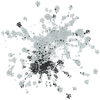NEW SURVEY QUESTIONS AND ESTIMATORS FOR NETWORK CLUSTERING WITH RESPONDENT-DRIVEN SAMPLING DATA
- PMID: 30337767
- PMCID: PMC6191199
- DOI: 10.1177/0081175017716489
NEW SURVEY QUESTIONS AND ESTIMATORS FOR NETWORK CLUSTERING WITH RESPONDENT-DRIVEN SAMPLING DATA
Abstract
Respondent-driven sampling (RDS) is a popular method for sampling hard-to-survey populations that leverages social network connections through peer recruitment. While RDS is most frequently applied to estimate the prevalence of infections and risk behaviors of interest to public health, such as HIV/AIDS or condom use, it is rarely used to draw inferences about the structural properties of social networks among such populations because it does not typically collect the necessary data. Drawing on recent advances in computer science, we introduce a set of data collection instruments and RDS estimators for network clustering, an important topological property that has been linked to a network's potential for diffusion of information, disease, and health behaviors. We use simulations to explore how these estimators, originally developed for random walk samples of computer networks, perform when applied to RDS samples with characteristics encountered in realistic field settings that depart from random walks. In particular, we explore the effects of multiple seeds, without replacement versus with replacement, branching chains, imperfect response rates, preferential recruitment, and misreporting of ties. We find that clustering coefficient estimators retain desirable properties in RDS samples. This paper takes an important step toward calculating network characteristics using nontraditional sampling methods, and it expands the potential of RDS to tell researchers more about hidden populations and the social factors driving disease prevalence.
Keywords: HIV/AIDS; clustering coefficient; estimation; hidden populations; respondent-driven sampling (RDS); sampling; small world model; social networks; transitivity; triad.
Figures




Similar articles
-
A SIMULATION-BASED FRAMEWORK FOR ASSESSING THE FEASIBILITY OF RESPONDENT-DRIVEN SAMPLING FOR ESTIMATING CHARACTERISTICS IN POPULATIONS OF LESBIAN, GAY AND BISEXUAL OLDER ADULTS.Ann Appl Stat. 2018 Dec;12(4):2252-2278. doi: 10.1214/18-AOAS1151. Epub 2018 Nov 13. Ann Appl Stat. 2018. PMID: 31632509 Free PMC article.
-
Does size really matter? A sensitivity analysis of number of seeds in a respondent-driven sampling study of gay, bisexual and other men who have sex with men in Vancouver, Canada.BMC Med Res Methodol. 2016 Nov 16;16(1):157. doi: 10.1186/s12874-016-0258-4. BMC Med Res Methodol. 2016. PMID: 27852234 Free PMC article.
-
A comparison of network sampling designs for a hidden population of drug users: Random walk vs. respondent-driven sampling.Soc Sci Res. 2017 Feb;62:350-361. doi: 10.1016/j.ssresearch.2016.08.016. Epub 2016 Aug 27. Soc Sci Res. 2017. PMID: 28126110
-
The development of respondent-driven sampling (RDS) inference: A systematic review of the population mean and variance estimates.Drug Alcohol Depend. 2020 Jan 1;206:107702. doi: 10.1016/j.drugalcdep.2019.107702. Epub 2019 Nov 1. Drug Alcohol Depend. 2020. PMID: 31761476
-
Respondent-driven sampling: Advantages and disadvantages from a sampling method.Medwave. 2022 Jan 3;21(1):e8513. doi: 10.5867/medwave.2022.01.002528. Medwave. 2022. PMID: 34979532 Review. English, Spanish.
Cited by
-
Estimating Hidden Population Sizes with Venue-based Sampling: Extensions of the Generalized Network Scale-up Estimator.Epidemiology. 2019 Nov;30(6):901-910. doi: 10.1097/EDE.0000000000001059. Epidemiology. 2019. PMID: 31299014 Free PMC article.
-
Social Network Clustering and the Spread of HIV/AIDS Among Persons Who Inject Drugs in 2 Cities in the Philippines.J Acquir Immune Defic Syndr. 2017 Sep 1;76(1):26-32. doi: 10.1097/QAI.0000000000001485. J Acquir Immune Defic Syndr. 2017. PMID: 28650399 Free PMC article.
-
Evaluating health status and risks among Native Hawaiian and Pacific Islander communities in Hawai'i: a respondent-driven sampling approach.Cancer Causes Control. 2025 May;36(5):521-530. doi: 10.1007/s10552-024-01956-3. Epub 2025 Jan 7. Cancer Causes Control. 2025. PMID: 39775483
-
Estimating Contextual Effects from Ego Network Data.Sociol Methodol. 2020 Aug;50(1):215-275. doi: 10.1177/0081175020922879. Epub 2020 Jun 2. Sociol Methodol. 2020. PMID: 32831423 Free PMC article.
-
One-step estimation of networked population size: Respondent-driven capture-recapture with anonymity.PLoS One. 2018 Apr 26;13(4):e0195959. doi: 10.1371/journal.pone.0195959. eCollection 2018. PLoS One. 2018. PMID: 29698493 Free PMC article.
References
-
- Barash Vladimir D., Cameron Christopher J., Spiller Michael W., and Heckathorn Douglas D.. 2016. “Respondent-Driven Sampling—Testing Assumptions: Sampling with Replacement.” Journal of Official Statistics 32 (1):29–73. doi:10.1515/jos-2016-0002. - DOI
-
- Britton Tom, Maria Deijfen, Lagerås Andreas N., and Mathias Lindholm. 2008. “Epidemics on Random Graphs with Tunable Clustering.” Journal of Applied Probability 45(3):743–56.
-
- Centola Damon, and Michael Macy. 2007. “Complex Contagions and the Weakness of Long Ties.” American Journal of Sociology 113 (3):702–34.
Grants and funding
LinkOut - more resources
Full Text Sources
